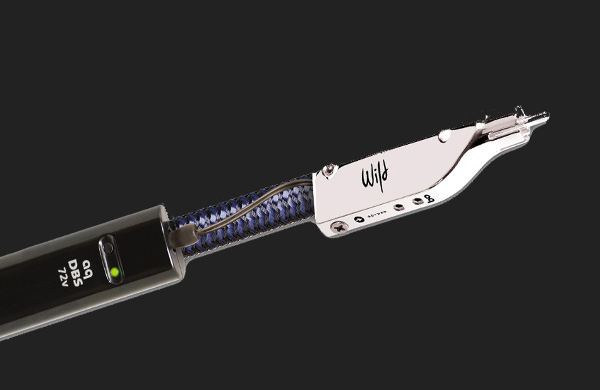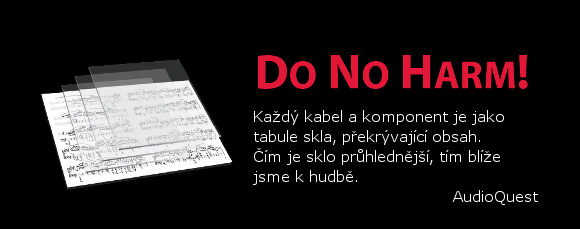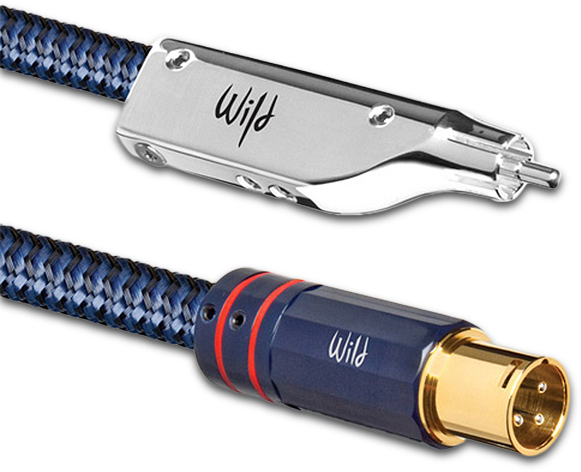AUDIOQUEST WILD BLUE YONDER
Is the AudioQuest brand completely new to you? If so you should re-enter a hifi nursery school to educate yourself. The most known cable manufactura of William E. Low produces a wide range of cables and accessories for all thinkable audio and video applications since early 80’s and though the majority of AudioQuest’s catalogue is what I would call upscale mass market, there is a bunch of top of the line cables that sound simply stunning. Let’s explore one of them.
Ahead of the pack
That week I summoned several very good interconnects: the feather-light brand new InAkustik 1603, the indigo-blue and sonically superb Cardas Clear and the almost invisible hair-thin CrystalConnect Piccolo Diamond. Any of them could be at home in an excellent audio line-up, although the Clear was easily topping the others. I had two balanced pairs of the Cardas Clear in my resident system and consider it the best piece of wire that has ever left George Cardas‘s production unit due its transparency and its natural ability to step out of the way of music. Within a week I was finished with my auditioning sessions with a clear view of each cable’s contribution and started packing them back to distributors but then doors slam opened and a red wolf pack rushed in. Well, not exactly the wolf pack but a deep blue interconnect with deep blue connectors and many wolves on its cardboard box*. I had Chesky’s great UDD Vol.2 SACD in my player so the newcomer replaced the Cardas Clear right away – no burning in, out-of-the-box.
The jazzy Club Descarga (The Body Acoustics) featured a great bass with a lightning fast attack through the AudioQuest. It rendered absolutely balanced sound without favoring neither the initial transient nor the string’s harmonics; it did not portray a bodyless instrument but a full fledged double-bass that was contoured, deep and fast. The accompanying guitar was washed in soft details of handwork as well as the bass clarinet was glowing with wood and brass and provided a great backdrop to metallic voicing of a trumpet. Very natural soundstage was extremely communicative and very fluid with pinpoint imaging and impeccable projection of relationships between instruments and musicians. By the time the track ended we had a new winner – the AudioQuest Wild Blue Yonder.
*) The wolves on the WBY’s packaging courtesy of Carole La Roche, Redwolf Pack, laroche-gallery.com

Deep Blue Yonder
The Wild Blue Yonder comes in deep blue polyesther-nylon braid and is quite tough so prepare for extra work to manipulate it to its final position. Also its proprietary XLR connectors (I had the balanced version for the review) are quite bulky and leave little room for your fingers. And, third, there are so called ‘DBS battery packs‘ attached to the cable that make the Wild Blue Yonder visually immodest
The Wild Blue Yonder belongs, together with Sky and WEL Signature cables, into the AudioQuest’s ’Cosmic’ series. It improves on the Sky with doubled diameter of Teflon dielectric tubes, different connectors and more elaborate shielding.
For the Cosmic range AudioQuest uses solid silver conductors that are polished (Perfect-Surface Technology). According to AudioQuest the solid conductors, unlike multistrand wires, prevent strand interaction, a major source of cable distortion. Extremely high-purity Perfect-Surface Silver minimizes distortion caused by the grain boundaries that exist within any metal conductor.
Dielectric material (read: insulation of a wire) is responsible for at least 50% of a cable performance and as such i tis extremely important. Any solid material adjacent to a conductor is actually part of an imperfect circuit. Wire insulation and circuit board materials all absorb energy (loss). Some of this energy is stored and then later released as distortion. All of Wild Blue Yonder’s conductors use Air-Tube insulation because air absorbs next to no energy, and FEP is the best extrudable solid insulation and absorbs less energy than other materials. Such insulation technology has been adopted by high-end manufacturers for years and some challenge it with breakthrough innovations – like Nordost with a thin filament that spirals around each wire to decouple it from the surrounding mass or Tara Labs that virtually vacuums the air out of their flagship cables.
Yet, some solutions are verified to yield the best results: e.g. crimping of connectors instead of soldering. AudioQuest uses proprietary connectors that are cold-welded (a combination of high pressure at the point of contact and the use of silver-impregnated paste) to ensure a superior connection and structural integrity of the connection. I had a balanced version at disposal which sports bulky gold-plated XLR connectors, however, if you prefer the RCA you will adore unusal looking plugs that will make your neighbors envy.
However, the DBS battery packs are the the most apparent feature of the Wild Blue Yonder. Everyone knows that a cable needs certain break-in period to perform optimally. According to AudioQuest the better the dielectric's insulation, the longer it takes for the cable to settle. A induced charge can come from simply moving the cable (due to piezoelectric effect and friction), or from high voltage testing at the final manufacturing stage. The cable that has a standing charge is measurably more microphonic and an uneven distribution of the charge causes something akin to structural return loss in a rising impedance system. How much time and use is required for the break-in is dependent on the design of the cable, materials used, treatment of the conductors during manufacture and other factors and manufacturers are still trying to find a reliable explanations to tackle the issue.
The patented DBS system (or dielectric bias system) that AudioQuest employs, creates a strong, stable electrostatic field which saturates and polarizes the molecules of the cable’s insulation. This minimizes both energy storage in the insulation and the multiple nonlinear time-delays that occur. All that should contribute to higher dynamic contrasts and greater transparency of sound.
The DBS packs are battery operated and as such the cable is permanently ´recharged´. There is a small LED that serves as functionality check if you are unsure whether the system is on.

Lightyears ahead of the pack
Within affordable limits (considering that affordability is a very flexible and subjective term) I was very impressed by the Cardas Clear for its ability to dissapear and encourage musical flow. I can heartily recommend the Clear for any but the best audio systems – it lets the system to do its job without trying to compensate its flaws and without adding any imprint. The AudioQuest Wild Blue Yonder shares all this with the Cardas Clear. It performas exactly like the company´s selling line suggests: ´Do No Harm´. On top of that the Wild Blue Yonder is a cable that outperforms the Clear and virtually induces the jaw-dropping effect. What makes it so outstanding?
The Wild Blue Yonder excels in what I would call temporal resolution or temporal phasing. Read it: no smearing, no ambiguity, only pure and clear view into music. The instruments and players are precisely locked within the soundstage with great three-dimensional dynamism as opposite to a static picture. I heard similar precision with Nordost Valhalla, yet the Wild Blue Yonder adds sonority and physical dimension of the Cardas Clear. The AudioQuest has better sense of detail than the Clear and throws its light into the darkest corners of a recording room to dig out the never heard nuancees and harmonies. For example, the piano in Club Descarga was very precisely defined in the background – it was not just a piano sound coming from the depth of the soundstage, it was a concrete instrument with its own dimensions and weight. I can only quote from my notes that superbly recorded congas are exhilaratedly colorful and very dynamic, the soundstage is open and alive and the trumpet is kind of holographic…
The vocal disc of Lamentations (Nordic Voices, Chandos, CHAN 0763, 24bit/96kHz) features lively acoustics of a Norwegian church in Hedmark with beautiful reverberation that blooms out in quiet contemplative passages. The voices do not arrive from the line of midrange drivers – they arrive from the plane that is approximately 50cm above the midrange drivers, which is much closer to the projection of a stand-up a cappella ensemble. Basses and barytones lament about the darkness that falls at the moment of Jesus‘s crucifixion in Tenebrae factae sunt (by the way, the event of the biblical solar eclipse has been documented by modern science). The lamentation is very emotive and the resonance of of voices sends thrills down the spine.
The Cardas Clear offers a little bit more comfort compared to the Wild Blue Yonder. It is not a night and day difference – just like listening to music from two armchairs with different upholstering. The softer one induces a more intensive feeling of cousiness and comfort though the quality of the music is the same. The Clear offers such a feeling. Its harmonies are more soothing, the voices are more human, the music has analog feel. The Wild Blue Yonder is an illumination champion and by rendering the venue of a recording it teleports a listener there. The AudioQuest is more visual, it is a bit easier to close the eyes and see the music and see the Hedmark’s church. The Clear, though not so precise, yields a kind of reverence and awe, which makes it so special for the spiritual music.
The Wild Blue Yonder is a tad more correct and sonically sophisticated – is it twice as correct and twice as sophisticate as its asking price is? At least it proves that an all-silver cable can sound absolutely neutral and natural, both gracious and glorious.

Chopin, Edelmann and mostly autumn
Here comes Balad # 1 in G-major, Op.23 (Exton Direct Cut Series, Triton OVCT-00058). The initial harmonies of this little piece of music became famous thanks to Steven Spielberg’s Close Encounters of The Third Kind. Sergei Edelmann’s performance is impeccable and having been issued on the limited Exton’s Direct Cut SACD series it represents probably the best recorded piano music I have ever heard. The price for this issue is sky high yet the sound exhibits such crystalline clarity and sonority that it is a must piece in a collection of both an audiophile and a music lover.
I have the piano in my listening room through the Cardas Clear – the string resonances, the release of the pedal, the relative position of a microphone and the instrument…everything is trackable with ease in the very open soundstage. I love especially the delicious nuancees like hearing reflections of the sound from an open upper part of the piano – what a hi-fi!
The fact that the AudioQuest Wild Blue Yonder yet improves on the Clear is beyond my understanding. The Wild Blue Yonder brings a new grade of illumination, the recording bathes in light and air and has unbelievable amount of subtle detail. I have not heard anything like that before. The sound flows like a pure water in a mountain stream and there are moments I would swear to feel its fragrance. For sure this is an overstatement but I feel it is appropriate to give you the idea of how good the WIld Blue Yonder is. Switching back to the Cardas the fragrance dissappears and the music becomes a tad darker, also due to the Clear’s weightier and fuller bass that makes the performance a delight when Edelmann travels left on the piano’s keyboard.
I wanted to know to what degree the AudioQuest’s mastery would be heard with rock music – would it be too delicate to deaden the drive and edge? Not really, the autumn guitar symphonies of Mostly Autumn (The Ghost Moon Orchestra, Mostly Autumn Records/Nova AUTO341) in spellbinding Tennyson Mansion were both fragile and majestic, sharp and tender. The wailing guitar was electrifying and so alive that I could not believe that it had been a cable that had made the difference. True, The Ghost Moon Orchestra is not a mastering masterpiece and its dynamics suffer from compression – it is even more suprising then how the AudioQuest uplifts the sound. Switching back to the Cardas again the purity and innocence was a bit suppressed. As good as the Clear was the Wild Blue Yonder was better.
Circumvence
I got a lesson from the AudioQuest while listening to This Swedish Jazz Kings Comes Love (Opus 3, 19703). The clarinet of Kenny Davern plays standing at about two meters from a microphone and the Wild Blue Yonder dissected his instrument into individual parts: I could precisely heard the length of the clarinet, defined by the lips on its reed and the air that outflew from the other end. It was a unique and phenomenal experience.
I did not have two pairs of the Wild Blue Yonder available so I could not make all the necessary connections in my SACD/preamplifier/power amplifier system (Accuphase DP-78/C-2420/A-60). After experiments when I switched the AudioQuest forth and back between any of the two components I used two tricks: first, the Accuphase allows for a direct connection of the variable output of the SACD player and the power amp, second, I used only one channel and listened in dual mono mode. Of course the latter case removed all soundstaging magic yet it was good for tonality and frequency checks, as well as for comparisons to the Cardas Clear. If you expect that I will now describe what l heard then do not. I will just say that after spending an evening in the mono-mood and after careful benchmarking I sat down with my calculator counting whether I could afford the two pairs of the Wild Blue Yonder. Not really, at its asking price of 4 600 €/m even one is way too expensive. The disappointment is the payback for breaching the golden rule of hi-fi: never listen to anything that you cannot afford!
The AudioQuest Wild Blue Yonder is the best interconnect I have ever heard, irrespective of price. It has everything – speed, transparency, dynamics, loads of detail, explosive transients, a great sense of pacing and rhythm and above all, musicality. It represents a quantum leap from the cheaper Sky (which is a real pricing parity for the Cardas Clear) and raises the inevitable question: how does the WEL Signature sound?
Important note: On several occassions I had an opportunity to audition AudioQuest cables (mostly speaker cables) that their owners sourced from internet auction sites. Some of them were apparently replicas that exhibited regretful craftsmanship and poor performance. If you buy such a look-alike cable you should expect low-end sound. In case of the top-of-the-range fakes you would also lose substantial sums of money. Therefore be cautious about what you buy!
Kontakt: AQ s.r.o., Červenka, tel. +420 585 342 232, www.aq.cz




